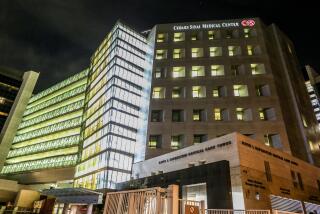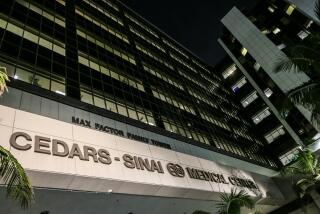Cedars-Sinai Taking Rare Step of Applying for Patents
- Share via
In a departure from tradition, Cedars-Sinai Medical Center in Los Angeles has become one of a handful of private hospitals not affiliated with universities to seek to patent new discoveries by staff researchers.
While many universities have had such a policy for years--mostly for nonmedical discoveries--few medical researchers have sought to file patents on their work. Traditionally, instead, they have chosen simply to publish their findings in scientific journals for the benefit of anyone who wants to use them.
But the Cedars-Sinai policy is to require researchers to apply for patents before publication.
Cedars-Sinai officials made the announcement in an article in one of the most prestigious of the medical publications, the New England Journal of Medicine, published today. Although Cedars-Sinai spokesmen indicated that the medical center has been quietly following such a patent policy for five years, today’s announcement seems certain to refocus attention on the ethics of such policies, which are becoming more prevalent in the medical community.
Paul M. Yaeger, vice president for planning at Cedars-Sinai, said that diminishing federal and private funding for research is forcing the medical center to adopt a more stringent policy in the hopes that patent royalties will augment the research budget.
Cedars-Sinai is a 1,200-bed nonprofit facility with a $5-million annual research budget. About 100 researchers are engaged in about 150 projects in a wide variety of medical disciplines ranging from cardiology to genetics. Although Cedars-Sinai is not the first non-university hospital to establish a patent policy--on the West Coast, Scripps Clinic in La Jolla is a pioneer--other hospitals with research programs are expected to follow.
In the Journal article, Yaeger and Stuart J. Marylander, Cedars-Sinai’s president, said the medical center now holds 17 patents and has filed 60 patent applications in 20 countries for medical devices and procedures ranging from cardiac laser surgery to hepatitis virus inactivation in blood products. In an interview, Yaeger said the royalties amount to about $1 million a year.
All new hospital employees--even part-time workers--are asked to sign a statement in which they agree to inform hospital officials of any discovery they make on hospital time and to share any royalties that may result from the marketing of the item. Inventors receive up to 50% of the royalties. A hospital committee has been set up to evaluate each discovery and determine whether it has a marketing potential.
According to the hospital officials, the first investigator to receive a patent has received more than $1 million in royalty income, which he may use as he wishes. The researcher, Dr. Alan Rubenstein, was credited with the 1980 discovery of a method of deactivating viruses in a blood product used by hemophiliacs. The method is used to eliminate the hepatitis and AIDS viruses from blood products.
In recent years there has been growing uneasiness in some segments of the medical profession over business arrangements that tie doctors too closely with the marketing of medical products. One concern is with the conflict of interest that can arise if a doctor allows his medical judgment to be influenced by his business interests.
Dr. Arnold Relman, editor of the New England Journal of Medicine, has become a leading spokesman against what he calls the “medical-industrial complex.” He has called on the medical profession to declare as an article of its ethical code that doctors should derive income only from their professional services and not from any kind of entrepreneurial interest in the health care industry. Relman could not be reached for comment on the Cedars-Sinai decision.






